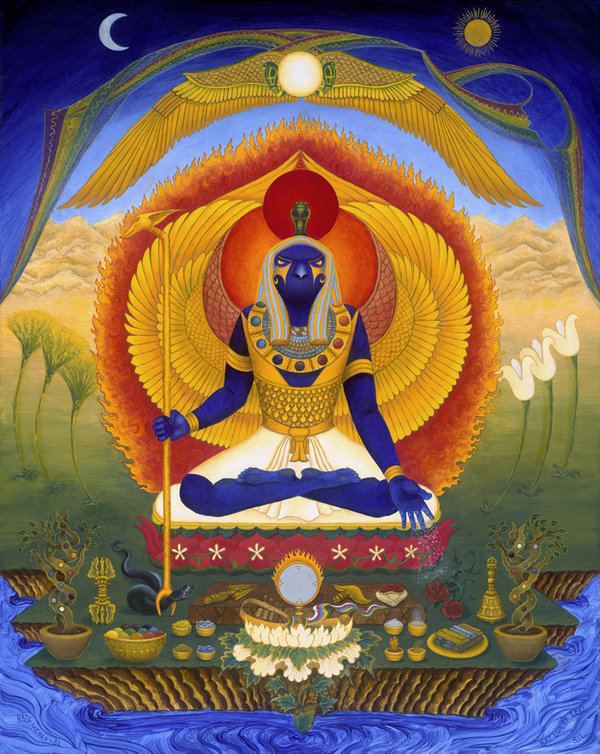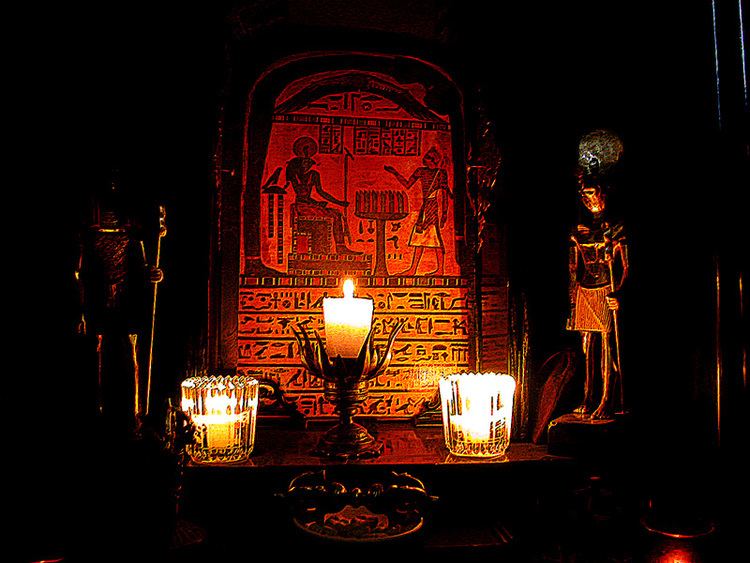 | ||
Aeon of horus heru ra ha
Heru (literally "Horus sun-flesh", among other possible meanings) is a composite deity within Thelema, a religion that began in 1904 with Aleister Crowley and his Book of the Law. Heru-ra-ha is composed of Ra-Hoor-Khuit and Hoor-paar-kraat. He is associated with the other two major Thelemic deities found in The Book of the Law, Nuit and Hadit, who are also godforms related to ancient Egyptian mythology. Their images link Nuit and Hadit to the established Egyptian deities Nut and Hor-Bhdt (Horus of Edfu).
Contents

Active aspect

The Active Aspect of Heru-ra-ha is Ra-Hoor-Khuit (Egyptian: Ra-Hoor-Khu-It, Ra-Har-Khuti or possibly Ra-Har-Akht), more commonly referred to by the Greek transliteration Ra-Herakhty, means "Ra (who is) Horus on the Horizon." Ra-Hoor-Khuit or Ra-Hoor-Khut is the speaker in the Third Chapter of The Book of the Law. Some quotes from his Chapter:

Within Thelema, Ra-Hoor-Khuit is called the Lord of the Aeon (which began in 1904 according to Thelemic doctrine), and The Crowned and Conquering Child.

According to the instructions that Crowley claimed to have received from the 8th Enochian Aethyr, the five-pointed "star of flame" symbolizes Ra-Hoor-Khuit in certain contexts.
An appellation of Ra, identifying him with Horus, this name shows the two as manifestations of the singular Solar Force. "Khuit" also refers to a local form of the goddess Hathor at Athribis, who guarded the heart of Osiris. "Khut" refers to the goddess Isis as light giver of the new year, and by some accounts can also mean the fiery serpent on the crown of Ra. This last meaning serves as a title of Isis in one of the hymns to "Isis-Hathor" at the Temple of Philae. Hathor also has the titles "Uraeus of Ra" and "Great Flame".
Passive aspect
The Passive Aspect of Heru-ra-ha is Hoor-pa-kraat (Egyptian: Har-par-khered), more commonly referred to by the Greek transliteration Harpocrates, meaning "Horus the Child"; Horus, the son of Isis and Osiris, sometimes distinguished from their brother Horus the Elder, who was the old patron deity of Upper Egypt. Hoor is represented as a young boy with a child's sidelock of hair, sucking his finger. The Greeks, Ovid and the Hermetic Order of the Golden Dawn attributed silence to him, presumably because the sucking of the finger is suggestive of the common "shhh"-gesture.
Aiwass, the being who dictated The Book of the Law to Crowley, in the book's first chapter introduces himself as "the minister of Hoor-paar-kraat."
Also known as "The Babe in the Lotus", Hoor-paar-kraat is sometimes thought of as the baby Ra-Hoor-Khuit and sometimes as the younger brother of Horus. The former interpretation in the works of Aleister Crowley portrays Ra-Hoor-Khuit—in place of the Golden Dawn's Osiris/Jesus -- as a model for the initiate, and thus describes attainment as a natural growth process, de-emphasizing the metaphor of death and resurrection. In the second interpretation, the Golden Dawn placed Hoor-paar-kraat at the center of their Hall of Ma'at while the officers of the temple (one of whom represented Horus) revolved around him.
Combined form
The Cry of the First Aethyr in Crowley's Liber 418 presents Horus, the Crowned and Conquering Child, as the union of many opposites.
It is a little child covered with lilies and roses. He is supported by countless myriads of Archangels. The Archangels are all the same colourless brilliance, and every one of them is blind. Below the Archangels again are many, many other legions, and so on far below, so far that the eye cannot pierce. And on his forehead, and on his heart, and in his hand, is the secret sigil of the Beast. (fn: Sun and moon conjoined) And of all this the glory is so great that all the spiritual senses fail, and their reflections in the body fail.(...)This child danceth not, but it is because he is the soul of the two dances, --- the right hand and the left hand, and in him they are one dance, the dance without motion.
